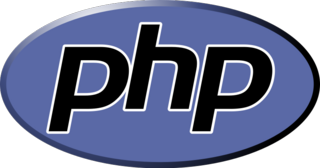PHP: Difference between revisions
imported>Dustin Meany (Added logo and removed non-linked items.) |
imported>Joshua David Williams (→Usage: added Syntax section) |
||
| Line 42: | Line 42: | ||
PHP is commonly used as the "P" in [[LAMP]] ([[Linux]], [[Apache HTTP Server|Apache]], [[MySQL]] and PHP/[[Perl]]/[[Python programming language|Python]]). Popular PHP applications include ''Drupal'', ''Joomla'', ''MediaWiki'', ''phpBB'', and ''WordPress''. Many web application frameworks, such as ''Symfony'' and ''CakePHP'' are also available for PHP. | PHP is commonly used as the "P" in [[LAMP]] ([[Linux]], [[Apache HTTP Server|Apache]], [[MySQL]] and PHP/[[Perl]]/[[Python programming language|Python]]). Popular PHP applications include ''Drupal'', ''Joomla'', ''MediaWiki'', ''phpBB'', and ''WordPress''. Many web application frameworks, such as ''Symfony'' and ''CakePHP'' are also available for PHP. | ||
===Syntax=== | |||
PHP code inside of a web page is placed inside of the <?php ?> tag. Unlike normal tags, <?php ?> contains the entire contents and ends with the closing of the tag itself instead of a slash tag, such as </php>. The syntax of the language itself is comparable to [[C programming language|C]], as demonstrated in the following [[Hello World]] example: | |||
<pre> | |||
<?php | |||
print "Hello World!"; | |||
?> | |||
</pre> | |||
==References== | ==References== | ||
Revision as of 16:12, 6 April 2007
PHP is a widely-used general-purpose scripting language that is especially suited for web development and can be embedded into HTML. PHP is a recursive acronym for PHP: Hypertext Preprocessor[1]. The sole implementation of PHP is provided by The PHP Group and released under the PHP License, which makes it free software.
PHP is mainly used for server-side scripting, but it can also be used for command-line scripting and for writing GUI applications (using the PHP-GTK extension)[2].
History
PHP is successor of PHP/FI (Personal Home Page/Forms Interpreter), a set of scripts created by Rasmus Lerdorf in 1995[3]. Initially, Lerdorf wrote a simple set of Perl scripts (Personal Home Page Tools) for tracking accesses to his online resume. Later, he wrote a much larger C implementation which had more functionality. On June 8, 1995, he released PHP Tools version 1.0 under GNU GPL[4]. PHP/FI 2.0 was released in November 1997, and had several thousand users.
In 1997, Zeev Suraski and Andi Gutmans of Technion - Israel Institute of Technology created PHP 3.0 as a complete rewrite of PHP/FI 2.0. The two decided to co-operate with Rasmus Lerdorf, and PHP 3.0 was announced as the official successor of PHP/FI 2.0. The name of the language was changed to the recursive acronym PHP: Hypertext Preprocessor. PHP 3.0 was officially released in June 1998, and at its peak, it was installed on approximately 10% of the web servers on the Internet[3].
Later, Andi Gutmans and Zeev Suraski began working on a rewrite of PHP's core, which resulted in the Zend engine (comprised of their first names, Zeev and Andi). PHP 4.0, based on the Zend engine 1.0, was officially released in May 2000. The new features in PHP 4.0 included support for more web servers, HTTP sessions, and several new language constructs. In 2002, Yahoo! began to phase out its own proprietary server-side scripting language, and started using PHP for web development[5].
PHP 5, driven by Zend Engine 2.0, was released on July 13, 2004. Its main features included robust support for object-oriented programming, a completely rewritten MySQL extension, a suite of interoperable XML tools, an embedded database with SQLite, cleaner error handling with exceptions, integrated SOAP implementation and iterators[6].
Usage
PHP is mainly used as a server-side scripting language in web-development. It runs on many web-servers such as Apache, lighttpd, and IIS. PHP will run under almost all operating systems and chip sets.
PHP is commonly used as the "P" in LAMP (Linux, Apache, MySQL and PHP/Perl/Python). Popular PHP applications include Drupal, Joomla, MediaWiki, phpBB, and WordPress. Many web application frameworks, such as Symfony and CakePHP are also available for PHP.
Syntax
PHP code inside of a web page is placed inside of the <?php ?> tag. Unlike normal tags, <?php ?> contains the entire contents and ends with the closing of the tag itself instead of a slash tag, such as </php>. The syntax of the language itself is comparable to C, as demonstrated in the following Hello World example:
<?php print "Hello World!"; ?>
References
- ↑ PHP:Introduction. PHP Manual.
- ↑ PHP:What can PHP do?. PHP Manual.
- ↑ 3.0 3.1 PHP:History. PHP Manual.
- ↑ Announce: Personal Home Page Tools (PHP Tools).
- ↑ PHP at Yahoo! presentation from Zend/PHP Conference.
- ↑ Adam Trachtenberg (2004-07-15). Why PHP 5 Rocks!.
